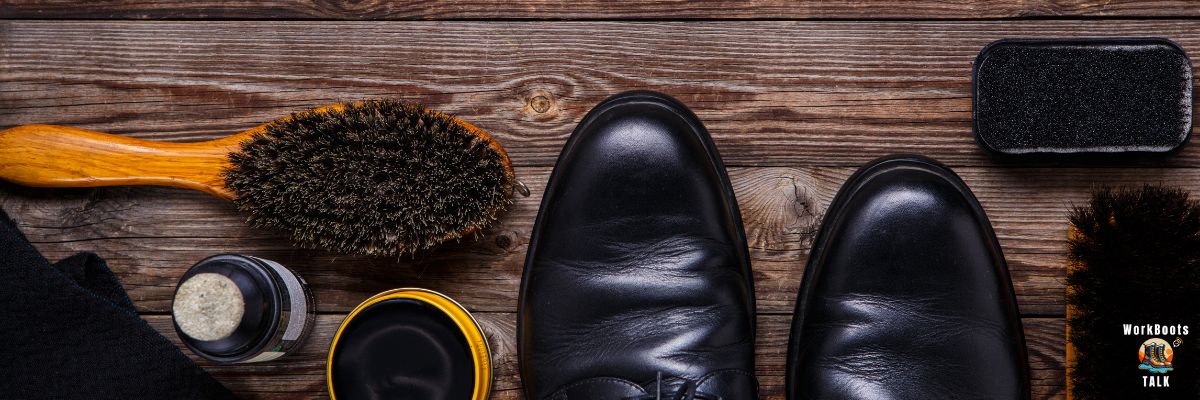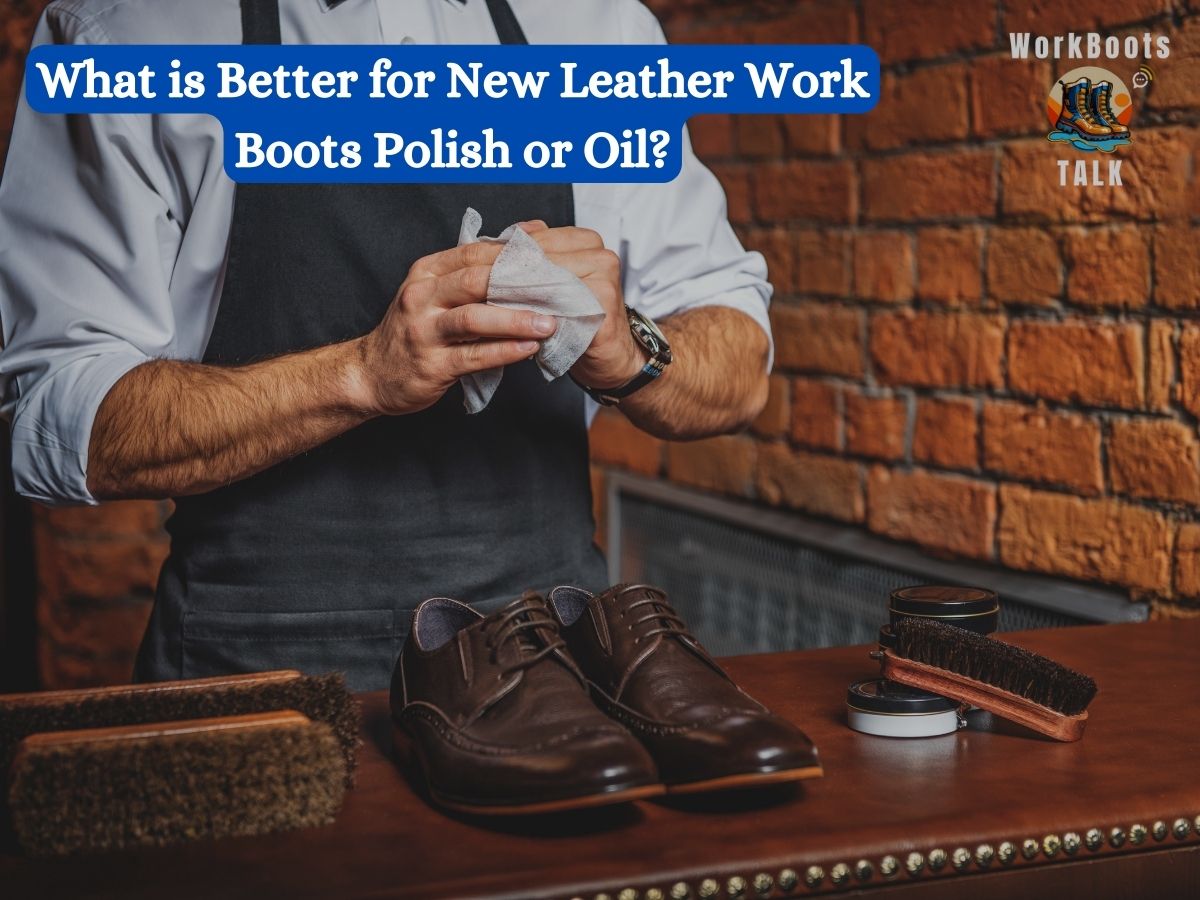Introduction: The Lifelong Dilemma of Maintaining Leather Boots
Owning a pair of leather work boots comes with the responsibility of keeping them in top condition. These boots, known for their style, comfort, and durability, are capable of enduring harsh weather, difficult terrain, and workplace hazards. To maintain their quality and aesthetics, it’s crucial to regularly care for them. A common quandary among leather boot owners is the choice between oil and polish for treatment. Each option has its benefits and drawbacks, influencing the overall look and feel of the boots. This article aims to delve into the advantages and disadvantages of using oil and polish on leather boots, guiding you in selecting the most suitable option for your footwear. Furthermore, it provides practical advice on the correct application of these treatments and highlights typical errors to avoid, potentially harming your boots. By the conclusion, you’ll be well-informed on how to extend the lifespan of your leather boots through proper maintenance.
Understanding Leather and Its Needs
Before diving into the benefits and drawbacks of using oil and polish on leather boots, it’s crucial to grasp the essence of leather and its requirements. Leather, a natural material obtained from the processed skins of animals like cows, sheep, goats, or pigs, boasts a combination of functional and aesthetic attributes. It is at once flexible and durable, aside from offering a distinct appearance and texture. It’s important to note that leather isn’t a homogenous or unchanging material. Its quality, texture, and color can significantly vary based on the source animal, the specific part of the hide used, and the methods employed in tanning and finishing. Furthermore, leather is a dynamic material that evolves over time, responding to factors such as moisture, sunlight, heat, and wear. Hence, leather demands targeted care to preserve its flexibility, and appearance, and to prevent issues like drying, cracking, fading, or staining.
The Nature of Leather
Understanding the nature of leather and its requirements is paramount in leather care. Leather consists of collagen fibers, forming an intricate network of pores and channels. These fibers endow leather with its strength and elasticity, while also rendering it porous and breathable. Consequently, leather can absorb and release moisture, oils, and dirt, both from its surroundings and from human skin.
This attribute implies that leather may gradually lose its inherent oils and moisture, particularly when exposed to dry or hot environments, causing it to become stiff, brittle, and susceptible to cracking. Preventing this requires nourishing and hydrating leather with products designed to replenish its natural oils and moisture, such as leather conditioners and oils. These products aid in maintaining leather’s flexibility, and durability, and contribute to its natural patina – the leather’s gradual darkening and enhanced shine over time.
Factors Affecting Leather Longevity
Being cognizant of the factors that influence leather’s longevity and knowing how to shield leather from these elements is another critical aspect of leather care. Key culprits include water, sunlight, heat, dirt, and friction. Exposure to water can cause the leather to swell, shrink, warp, or grow mold. Sunlight exposure might cause the leather to fade, discolour, or dry out.
Heat can make leather dry, crack, or harden, whereas dirt can block leather’s pores, tarnish its surface, or stain its hue. Friction, on the other hand, can lead to wear, tears, or scuffs. To safeguard leather from these threats, it should be regularly cleaned and conditioned, along with being treated with products that create a protective barrier, like leather polishes and waxes. These measures help leather to repel water, dirt, and abrasion, whilst boosting its overall look and shine.
The Case for Oil: Nourishing Your Boots from the Start
Having gained a deeper insight into the nature of leather and its needs, let’s delve into why oil is an essential care product for your new leather boots. Oil stands out in leather care for its ability to deliver multiple benefits; it nourishes, moisturizes, softens, and safeguards your boots right from the beginning, fostering a stunning patina as they age. Nevertheless, it’s crucial to understand that not all oils are alike, with some being better suited for your leather boots. We’ll cover the advantages of oiling new leather boots, identify the best types of oils, and provide some guidance on how to apply these oils effectively.
Benefits of Using Oil on New Leather Boots
Applying oil to new leather boots greatly nourishes and hydrates the leather fibers, preventing them from becoming dry and cracked. It penetrates the leather deeply, replenishing the natural oils and moisture it loses over time. This process maintains the leather’s flexibility and strength while also enhancing its natural patina – a process where leather darkens and gains shine over time.
Additionally, oil softens and conditions the leather, making your boots more comfortable and easier to break in, thus minimizing the risk of blisters. It also revitalizes old or dried-out boots, restoring their color and texture. Furthermore, oil acts as a protector and waterproofer, imparting water repellency, making your leather boots more resistant to water, dirt, and wear and promoting a watertight barrier that helps your boots endure harsh weather and reduce scuffs and scratches.
Types of Oil Suitable for Leather Boots
While many oils can be used for leather boots, the most effective are mink oil, neatsfoot oil, and beeswax oil. Mink oil, derived from the fat of minks, excellently moisturizes, softens, and waterproofs, encouraging a rich patina over time.
However, it can darken leather, so it might not be the best choice for lighter boots. Neatsfoot oil, from cattle’s feet and shin bones, also softens, conditions, and helps maintain leather’s elasticity, though it too can darken the material. Beeswax oil, made from beeswax, not only moisturizes and protects but also polishes leather, offering water, dirt, and abrasion resistance and a smooth finish. Note, though, that beeswax oil can leave a sticky residue and might not penetrate as deeply as other oils.
Application Tips for Oil on New Leather
To ensure optimal results when oiling new leather boots, begin by thoroughly cleaning them to remove any debris. You can use a damp cloth, soft brush, or leather cleaner for this step. To address issues of water resistance, waterproofing products can be used alongside natural oils. Coconut oil is a favourite among enthusiasts for its leather-making benefits, providing a light, naturally-derived option that doesn’t overly darken the material.
For a shinier appearance, a shoe shiner might be utilized as part of the boot polish regimen. After applying the chosen oil or coconut oil, let the boots absorb the treatment. Then, if the manufacturer’s suggested retail price (MSRP) allows for additional investments, consider opting for high-grade shoe polishes for an added layer of protection and shine. Allow the boots to dry entirely in a cool, dry place away from direct heat or sunlight, and complement your care routine with accessories such as gloves, face coverings, and a hard hat as part of your personal protective equipment when working in tough conditions.

The Role of Polish: Protecting and Enhancing Leather Aesthetics
While oil is a well-known product for maintaining the quality of your leather boots, polish serves as an equally valuable alternative, offering protection, shine, and even color. However, not all polishes are created equal, and the right choice can greatly depend on the type of leather you’re working with. In this section, we’ll dive into the benefits of using polish on your leather boots, explore various types of polish available, and share effective application techniques for impeccable results.
Advantages of Using Polish on Leather Boots
One significant benefit of applying polish is its ability to shield the leather from water, dirt, and abrasion. A fine layer of wax or resin created by the polish seals the leather’s pores, repelling moisture and stains. This not only reduces the risk of scuffs and scratches but also contributes to the longevity of your boots.
Furthermore, polish can dramatically enhance the look of leather, giving it a smooth, glossy appearance that speaks elegance. It helps in preserving or rejuvenating the color of your leather boots, camouflaging any signs of fading or wear. Additionally, when used alongside oil—a substance that moisturizes leather from within—polish ensures your boots receive comprehensive care.
Different Types of Leather Polish
Among numerous options, cream, wax, and liquid polishes stand out for their effectiveness. Cream polish is known for its soft, creamy texture, incorporating either natural or synthetic oils and waxes to moisturize, condition, and mildly shine leather. It’s straightforward to apply and generally suits most leather types, albeit with potentially lesser durability and shine compared to other polishes.
Wax polish, on the other hand, offers robust protection and a high-gloss finish thanks to its concentration of beeswax or carnauba wax. Ideal for dressier footwear, it may, however, pose challenges in application and could dry or crack the leather if overused. Liquid polish, featuring solvents and synthetic resins, promises a speedy shine and coloration method, though it might lack the conditioning benefits of other forms and leave behind an undesirable residue.
Applying Polish: Techniques for Best Results
To achieve the most favourable outcome when polishing leather boots, begin by thoroughly cleaning them to remove any impurities. Utilize a damp cloth, soft brush, or designated leather cleaner for this task. Next, select a polish that aligns with your boot’s leather type, color, and condition, testing it on a less visible section to gauge its effect. When applying, aim for a thin, uniform coat using a clean cloth, sponge, or brush, making sure to rub in the direction of the grain to avoid clogging the pores.
Allow the polish to dry for about 10 minutes before buffing with a horsehair brush or cloth for an enhanced shine. Optionally, a damp cloth or cotton ball can be used for a more pronounced gloss. Ensure your boots are thoroughly dry before usage, and stored in a cool, dry locale away from direct heat sources. Regular polishing, based on usage frequency and exposure to elements, will keep your leather boots in top condition.
Oil vs. Polish: Making the Right Choice for Your Leather Boots
When it comes to leather care, both oil and polish play distinctive roles. Your choice between using oil, polish, or a combination of the two depends on your leather boots’ type, color, and condition. For example, if you’re dealing with suede shoes, waterproofing should be a priority due to suede’s susceptibility to water damage. Methods such as using a dedicated suede protector can enhance water resistance without compromising the shoe’s texture.
Additionally, introducing insoles can increase comfort, and using suede-specific boots polishing techniques can maintain their pristine look. If a glossy finish is desired, multiple layers of high-quality boot polish may be applied. Remember that a solid boots polishing routine will also include the use of a washer to keep socks and other washable shoe inserts fresh and clean. Ultimately, harmonizing your use of oil and shoe polishes can ensure that your footwear remains in prime condition, providing both practical durability and an attractive appearance.
When to Use Oil Over Polish
Oil is particularly beneficial for new leather boots, providing essential nourishment and moisture to keep the leather fibers from drying and cracking. Additionally, oil aids in softening and breaking in new boots for enhanced comfort and flexibility. It’s also the go-to for reviving old or dried-out boots, boosting their color and texture. If your boots have a natural or matte finish, oil can enhance their patina and character. Oil offers some protection against water, dirt, and abrasion, though it may not be sufficient for boots requiring extra protection or shine. Consider oil for your leather boots to:
- Maintain hydration and condition in new, old, or dry boots
- Soften and ease the break-in process for stiff boots
- Highlight the natural patina and character of your boots
- Preserve a natural or matte finish
When Polish is the Preferable Option
For boots needing more protection and a glossy finish, polish is the ideal choice. It lays down a protective barrier against water, dirt, and stains while helping maintain or revive the color, masking fading or discoloration. Moreover, polish mitigates wear and tear, minimizing scuffs and scratches. It grants a smooth, refined shine, perfect for boots with a smooth or glossy surface. Polish complements oil efficiently—while oil conditions the leather internally, polish adds external protection and luster. Opt for polish for your boots to:
- Shield and waterproof against water, dirt, and stains
- Maintain or rejuvenate the color of your boots
- Reduce the appearance of scuffs and scratches
- Achieve a smooth and glossy finish
Combining Both for the Best of Both Worlds
If you aim to maximize your leather boots’ longevity and appeal, blending oil and polish is an effective strategy. This dual approach lets you nourish, moisturize, protect, and shine your boots. Still, it’s crucial to be mindful of application order and frequency to prevent potential damage. Here are some recommendations for harmonizing oil and polish use:
- Apply oil before polishing to ensure deep leather penetration, with the polish forming a protective surface layer afterwards.
- Use both oil and polish moderately and evenly with a clean cloth, sponge, or brush to avoid pore clogging and dullness.
- Let both products dry thoroughly before buffing or wearing the boots. A hair dryer can expedite this, but avoid excessive heat to prevent leather damage.
- Regular, but not excessive, oil and polish application is key. The frequency depends on usage and exposure conditions, but generally, once every few weeks to months is adequate. Avoid treatments more than once a month to circumvent leather saturation and deterioration.
Mastering the art of applying polish and oil to your leather work boots is key to ensuring their longevity and visual appeal.
Where You Work Matters: Environmental Considerations
Understanding how environmental factors can impact your leather work boots is crucial for effective maintenance.
- Hot and Dry Conditions: In hot and dry climates, leather is prone to dehydration and cracking. The lack of moisture can strip the natural oils from the leather, leading to stiffness and potential damage. Regular conditioning with oils becomes essential in such environments to maintain the leather’s suppleness and prevent premature ageing.
- Wet and Humid Environments: On the flip side, wet and humid conditions pose a different set of challenges. Excessive moisture can lead to mold growth and leather deterioration. It’s crucial to allow boots to air-dry naturally and avoid direct heat sources. Additionally, using products that offer water resistance, such as polish, becomes vital to protect the leather from the adverse effects of prolonged exposure to dampness.
Considering these environmental nuances ensures that your leather work boots are appropriately cared for, extending their lifespan and performance regardless of the climate they encounter..

